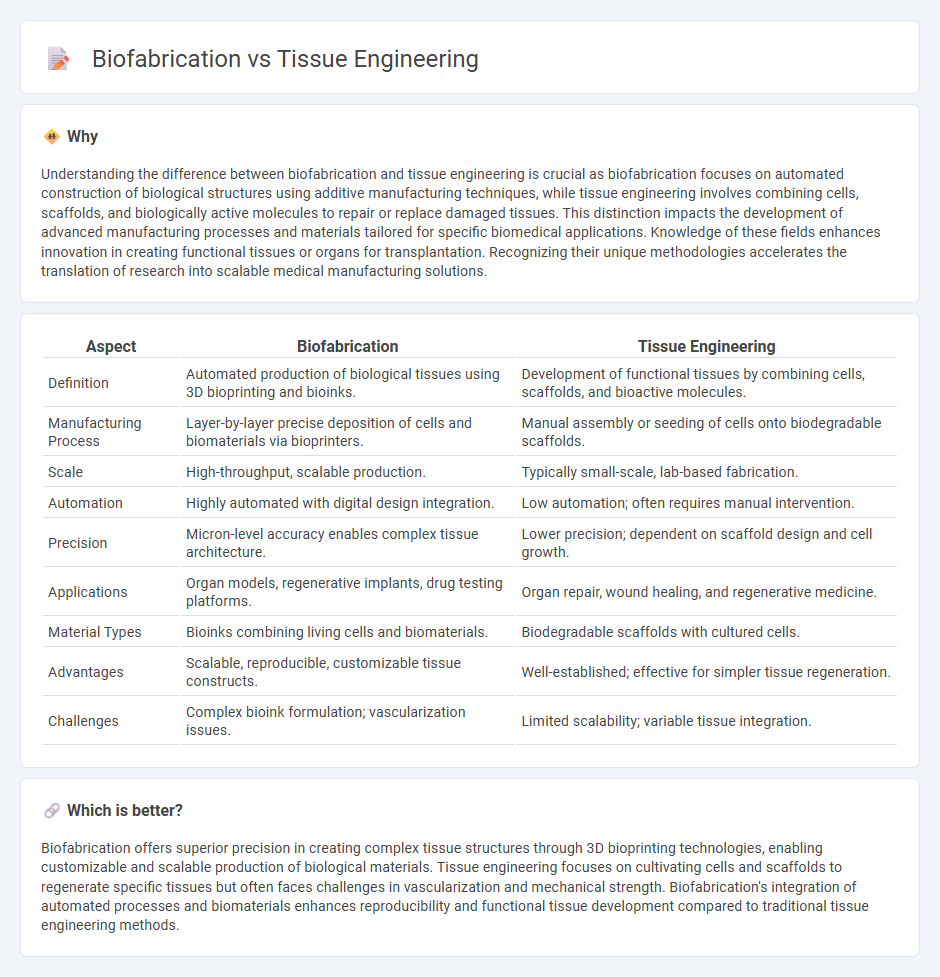
Biofabrication leverages advanced 3D bioprinting technologies to construct complex biological structures layer by layer, enabling precise control over cell placement and scaffold architecture. Tissue engineering focuses on developing functional tissue constructs through the combination of cells, biomaterials, and biochemical factors to regenerate or replace damaged tissues. Explore the latest innovations and comparative advancements in biofabrication and tissue engineering to deepen your understanding.
Why it is important
Understanding the difference between biofabrication and tissue engineering is crucial as biofabrication focuses on automated construction of biological structures using additive manufacturing techniques, while tissue engineering involves combining cells, scaffolds, and biologically active molecules to repair or replace damaged tissues. This distinction impacts the development of advanced manufacturing processes and materials tailored for specific biomedical applications. Knowledge of these fields enhances innovation in creating functional tissues or organs for transplantation. Recognizing their unique methodologies accelerates the translation of research into scalable medical manufacturing solutions.
Comparison Table
| Aspect | Biofabrication | Tissue Engineering |
|---|---|---|
| Definition | Automated production of biological tissues using 3D bioprinting and bioinks. | Development of functional tissues by combining cells, scaffolds, and bioactive molecules. |
| Manufacturing Process | Layer-by-layer precise deposition of cells and biomaterials via bioprinters. | Manual assembly or seeding of cells onto biodegradable scaffolds. |
| Scale | High-throughput, scalable production. | Typically small-scale, lab-based fabrication. |
| Automation | Highly automated with digital design integration. | Low automation; often requires manual intervention. |
| Precision | Micron-level accuracy enables complex tissue architecture. | Lower precision; dependent on scaffold design and cell growth. |
| Applications | Organ models, regenerative implants, drug testing platforms. | Organ repair, wound healing, and regenerative medicine. |
| Material Types | Bioinks combining living cells and biomaterials. | Biodegradable scaffolds with cultured cells. |
| Advantages | Scalable, reproducible, customizable tissue constructs. | Well-established; effective for simpler tissue regeneration. |
| Challenges | Complex bioink formulation; vascularization issues. | Limited scalability; variable tissue integration. |
Which is better?
Biofabrication offers superior precision in creating complex tissue structures through 3D bioprinting technologies, enabling customizable and scalable production of biological materials. Tissue engineering focuses on cultivating cells and scaffolds to regenerate specific tissues but often faces challenges in vascularization and mechanical strength. Biofabrication's integration of automated processes and biomaterials enhances reproducibility and functional tissue development compared to traditional tissue engineering methods.
Connection
Biofabrication and tissue engineering are interconnected fields focused on creating functional biological tissues through advanced manufacturing techniques. Biofabrication uses 3D bioprinting and scaffold fabrication to construct complex tissue structures, while tissue engineering provides the cellular and molecular components essential for replicating native tissue functions. Together, they drive innovations in regenerative medicine by enabling the production of viable tissue substitutes for transplantation and disease modeling.
Key Terms
Tissue engineering:
Tissue engineering involves creating functional biological tissues by combining cells, scaffolds, and bioactive molecules to restore or replace damaged tissues. It emphasizes scaffold design, cell seeding techniques, and the biochemical environment to promote tissue regeneration and integration with host tissue. Explore our detailed insights to understand the latest advancements and applications in tissue engineering.
Scaffolds
Tissue engineering relies on scaffolds as three-dimensional structures that support cell attachment, proliferation, and differentiation, often using biodegradable materials like collagen and polylactic acid to mimic the extracellular matrix. Biofabrication advances this concept by employing automated additive manufacturing techniques such as 3D bioprinting, allowing precise spatial distribution of cells and biomaterials to create complex tissue constructs with improved integration and functionality. Explore the latest innovations in scaffold technologies to understand their evolving roles in regenerative medicine and personalized therapies.
Cell seeding
Cell seeding in tissue engineering involves manually placing cells onto scaffolds to promote tissue formation, while biofabrication employs automated, precision techniques such as 3D bioprinting for spatially controlled cell deposition. Advances in biofabrication allow for higher cell viability and complex tissue architectures compared to traditional cell seeding methods. Explore further to understand how these innovations shape regenerative medicine.
Source and External Links
Tissue engineering - Wikipedia - Tissue engineering is a biomedical engineering discipline combining cells, materials, and biochemical factors to restore, maintain, improve, or replace biological tissues, often using cells on scaffolds to form new tissue for medical use.
Tissue engineering: strategies, stem cells and scaffolds - PMC - Tissue engineering strategies include using scaffolds seeded with cells in vitro to produce tissue for transplantation or using scaffolds as growth factor delivery systems to recruit cells in vivo, with scaffold design influencing cell behavior and tissue formation.
Tissue Engineering and Regenerative Medicine - NIH Fact Sheet - The goal of tissue engineering is to assemble fully functional constructs that restore or improve damaged tissues or organs by combining scaffolds, cells, and bioactive molecules, with applications including engineered skin and cartilage, and with overlap to regenerative medicine.
 dowidth.com
dowidth.com